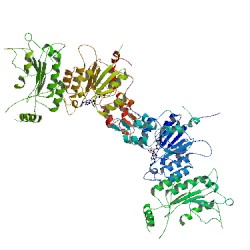
I looked for a News and Views summary of the article, thinking that if the conclusions of the article were anything like what the title and abstract indicated, there must be an editorial summary. I wasn’t disappointed. Su and Tsai provided a nice summary of the paper and discussed some of the potential implications of the work (2).
Epigenetics, affecting gene expression and/or function through chemical modifications of DNA or histone proteins that do not affect the actual DNA sequence, is a field of study that has been around a while—even those of us who came of age in the “one gene, one graduate student” era learned about epigenetic modifications in our classes.
A fair amount is known about epigenetic events during development and cell differentiation, and epigenetic events can influence the development and progression of cancers (3). More startlingly perhaps, is evidence that epigenetic patterns can be passed from one generation to the next (4). As cited in both the Oliveira et al. paper and the Su and Tsai review, DNA methylation is implicated in long-term neural processes such as memory formation, and aged animals exhibit hypomethylation in many tissues including nervous tissues. These observations led Oliveira et al. to ask if hypomethylation might play a role in age-related cognitive decline.
To address this question, they first asked if there was any correlation between the abundance of mRNA transcripts of DNA methyltransferase genes in the hippocampus and cortex and aging in mice. When they looked at the two splice variants of the Dnmt3a gene (3a1 and 3a2), they found that the Dnmt3a2 transcript was expressed in a pattern similar to that of classical immediate early genes (IEG) associated with learning and memory and was activated in response to NMDA (N-methyl-D-aspartate) receptor activity. This activity was reduced in the hippocampus of aged mice.
Since Dnmt3a2 was associated with euchromatin and responded like an IEG, and its expression was reduced in aged mice, the authors attempted to see if they could influence cognitive ability in aged mice by altering Dnmt3a2 in levels. They used a recombinant adeno-associated virus (rAAV) containing an expression cassette for hemagglutinin (HA)-tagged Dnmt3a2. Overexpression of Dmnt3a2 in the hippocampus of aged mice increased DNA methylation in the hippocampus.
Next they used two separate measures of cognition to compare aged mice in which Dmnt3a2 was overexpressed to control mice: trace fear conditioning and object location memory.
For the trace fear conditioning experiment, mice were exposed to a conditioned stimulus (a tone) followed by an unconditioned stimulus (foot shock). Aged mice injected with rAAV containing the HA-tagged Dmnt3a2 construct showed a higher freezing response to the tone, suggesting improved memory. Aged mice injected with a rAAV HA-green fluorescent protein (GFP) control construct did not show the same freezing response.
For the object location memory experiment a mouse was trained to locate an object in an open area, then the researchers measured the mouse’s exploration of the object when it was moved to a new location. Aged mice injected with the rAAV HA-Dmnt3a2 construct were able to identify the change in the object’s location 24 hours after training. Aged mice injected with the rAAV HA-GFP control construct could not.
Since experiments in aged mice suggest that overexpression of Dmnt3a2 in the hippocampus is sufficient to restore some cognitive function, the next question the researchers asked was “will reduction in Dmnt3a2 in young mice reduce cognitive function?”
For these experiments, they used the same cognitive function tests described above, only they delivered a Dnmt3a2 small hairpin RNA (shRNA) using the rAAV vector to reduce Dnmt3a2 expression by RNA interference. No gross affects on the tissue morphology of the hippocampus were observed. However, young mice receiving the Dnmt3a2 shRNA did not show the same freeze response as the control group, suggesting impaired cognitive response 24 hours after training; however, 1-hour-after-training freeze responses between the two groups were similar, suggesting that only long-term memory was affected. Similar results were observed with the object location test.
This study is particularly intriguing because DNA methylation has traditionally been thought to act as a transcriptional repressor. However, reduction of Dnmt3a2 expression led to decreased expression genes involved in neural plasticity, leading the authors to suggest that methylation may also be a transcriptional activator. Finding where the expression of this methyltransferase fits in the multitude of events that are associated with neural plasticity, memory formation and learning, remains an intriguing task.
So, to get back to the question in my title: Can age-related cognitive decline in mice be rescued by a single gene? Certainly aged mice improved on two tasks with over expression of Dmnt3a2, and suppressing Dmnt3a2 in young mice impaired function, so the authors did move from a simple correlation study toward causation. This study a meaningful first step, but we will need to look at the affects of this gene in a variety of genetic backgrounds and in a variety of organisms to fully appreciate how it integrates into what is surely a highly complex and interwoven network of signaling pathways that regulate neural plasticity, memory and cognitive function.
References
- Oliveira, A.M.M., Hemstedt, T.J. & Bading, H. (2012). Rescue of aging-associated decline in Dnmt3a2 expression restores cognitive abilities, Nature Neuroscience, 15 (8) 1113. DOI: 10.1038/nn.3151
- Su, S.C. and Tsai, L-H. (2012) DNA methylation in cognition comes of age. Nature Neuroscience 15, 1061–2.
- Zaidi, S.K. et al. (2011) Bookmarking the genome: Maintenance of Epigenetic Information. J. Biol. Chem. 286, 18355–61.
- Skinner, M.K. (2011) Environmental epigenetic transgenerational inheritance and somatic epigenetic mitotic stability. Epigenetics 6, 838–42.
